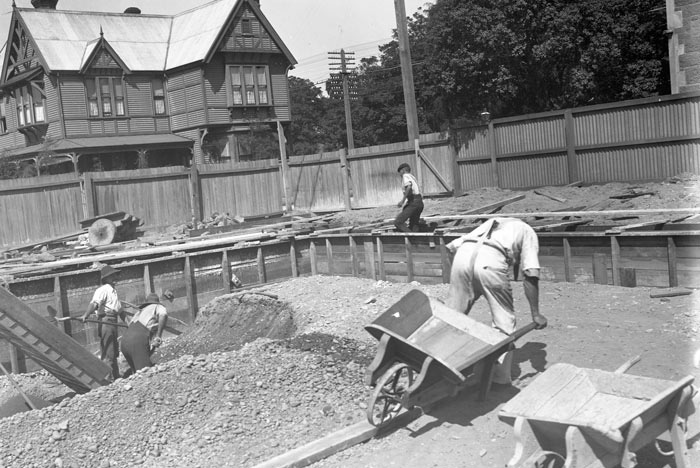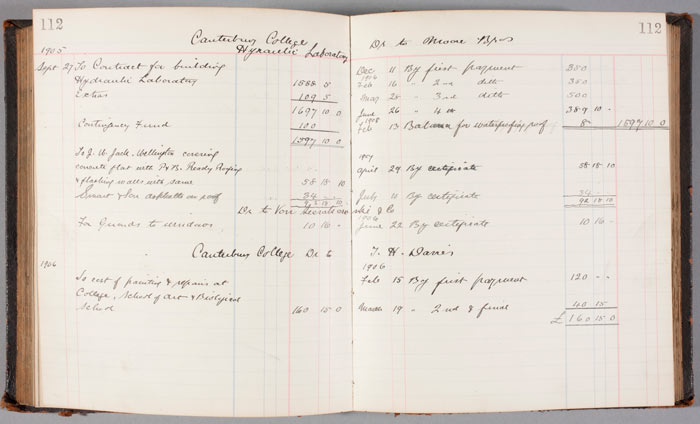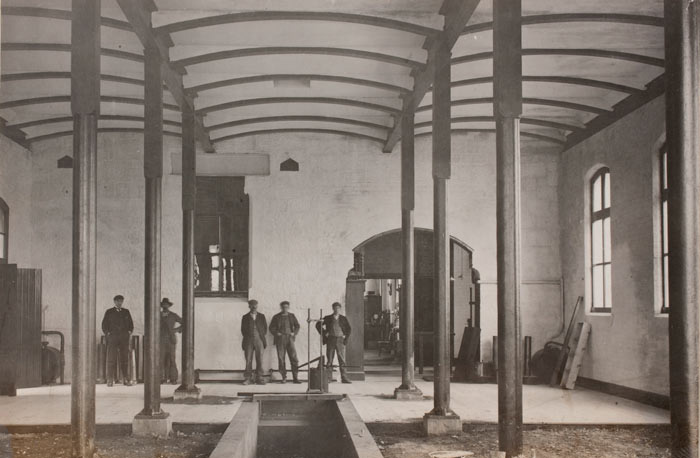Completing the drawings and specifications was only the first half of the architect’s job. Once the tenders had been let, supervision of construction and negotiation with contractors began. On major contracts there was usually a Clerk of Works based on the site to supervise workmen. However, the architect would also visit the site regularly to check on progress. For example William Armson closely supervised building sites, visiting regularly and sending letters to detail any changes to be made. His letterbook indicates that he frequently reminded his Clerk of Works to adhere to instructions strictly, and was not afraid to correct builders or contractors for poor work. The chain of command was however always respected. In 1897 Armson wrote “I have nothing to do with workmen unless their incompetency or misconduct call for the exercise of clause 20 of the Conditions of Contract.”

Contracts, Construction ad Clients

Workmen from W.Greig and sons digging out the foundations for the new Chemistry Laboratory, 1908.
Armson's habits must have rubbed off on his apprentices. R.D. Harman was renown for using a penny farthing cycle to visit country sites to check on progress, while J.J. Collins can be seen visiting Canterbury College construction sites in numerous images in the Armson Collins Collection. The firm’s extensive photograph collection shows that they visited sites and took photographs as construction proceeded, and then kept images of completed buildings as a showcase of their accomplishments.
With high standards to be met, architects would have looked for contractors who were reliable and proved themselves to be trustworthy. It appears that the Armson Collins firm established a good working relationship for example with the Greig and Graham families. William Greig and Sons are signatories to numerous early contracts on the College site, including the Clock Tower, the Boys' High School and the Chemical Laboratory in 1908. The firm of Graham and Greig were then contracted by Armson Collins, and later P. Graham and sons built the extensions to School of Engineering in 1920s and were involved in College Library construction.

The Armson Collins Contract Book, showing the details for the Canterbury College Hydraulic Laboratory stage one, 1905.
Inevitably, part of the architect’s job was to navigate relationships with a variety of clients. Sometimes, differences of opinion could be sorted relatively easily. When William Armson designed St Mary’s Church in Timaru his original sketch included a spire. In viewing the drawings the Church Building Committee thought the spire would look a lot better just a little higher. Fortunately Armson agreed with them, and when the Committee asked why he hadn’t drawn it higher in the first place, he replied that the paper he had used wasn’t long enough.
In some cases however, disagreements led to more complicated situations. In 1913 Collins and Harman found themselves in difficulty over the design of the Hydraulics Laboratory. Head of Engineering Professor Robert Julian Scott and his staff believed the design of the piers supporting the water tank for the building required strengthening. Scott took his concerns to the Board of Governors and they in turn wrote to the architects, who were not impressed. Collins and Harman wrote back “As he is not an Architect we do not consider his opinion or design worth consideration." Undeterred, Scott persevered with his complaint, until the design of the building was changed.

An inspection of work on the Hydraulics Laboratory, showing the interior of the ground floor.
Whatever the nature of the design, both criticism and praise were certain to follow. Flying in the face of popular opinion for example, the same Professor Scott was happy to debate both style and function with the College architects over the years. In the 1923 Christchurch Press supplement on Jubilee of College, Scott wrote “The original portions of the College designed by the late B.W. Mountford [sic] have won praise from expert critics, among whom the writer does not number himself…"